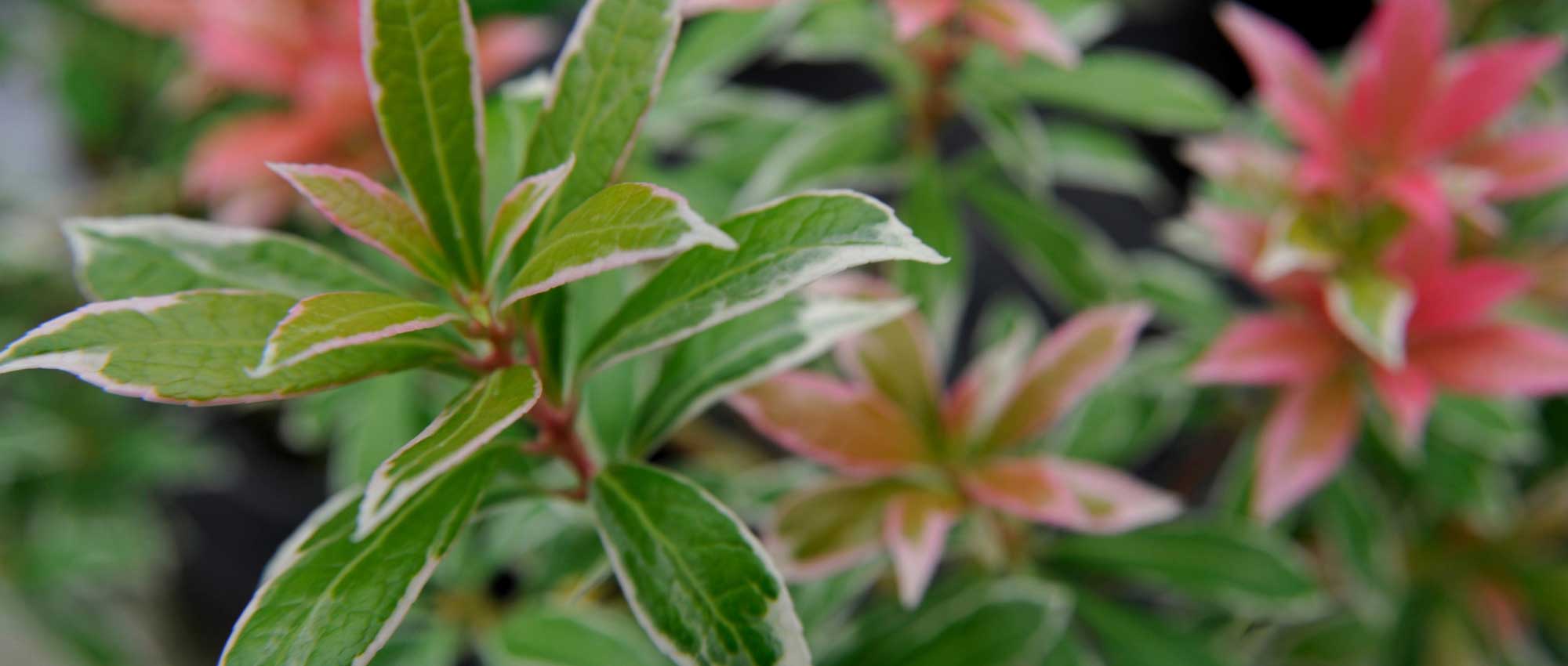
Pieris japonica: planting, pruning and care
Contents
Pieris japonica in a nutshell
- Pieris or Japanese Andromeda is appreciated for its colourful young shoots, often bright red!
- In spring, it offers a decorative flowering, with a multitude of white or pink bell-shaped flowers.
- With its evergreen foliage, it remains decorative throughout winter!
- It is easy to cultivate and requires very little maintenance.
- It thrives in slightly acidic soil and in a semi-shaded position.
A word from our Expert
The Japanese Andromeda, or Pieris japonica, is a decorative heather soil bush with evergreen and glossy foliage, whose young shoots take on scarlet red hues. It will bring a lot of colour to a hedge or as a backdrop in a flowerbed! Although it is mainly grown for its unique foliage, the Pieris offers a lovely spring flowering, sometimes impressive. The flowers form small white or pink bell-shaped blooms gathered in panicles.
The Pieris is a hardy plant that prefers rather acidic, cool but well-draining substrates, and thrives in partial shade. It is planted in spring or autumn. Pruning is not obligatory, but you can do it to control its growth. There are compact varieties suitable for pot cultivation! In the garden, it pairs wonderfully with other heather soil bushes, such as rhododendrons, skimmia, or camellias.
Botany
Botanical data
- Latin name Pieris japonica
- Family Ericaceae
- Common name Japanese Andromeda
- Flowering between March and May
- Height up to 4 metres
- Exposure partial shade
- Soil type acidic, cool, well-drained
- Hardiness at least down to -15 °C
Japanese Andromeda, or Pieris japonica, is an evergreen bush with decorative foliage and spring flowering. As its name suggests, it is native to Asia: it can be found in Japan, but also in China and Taiwan. There are also other species: the genus Pieris includes six, some of which come from North America, such as Pieris floribunda or Pieris cubensis (native to Cuba).
The Japanese Andromeda belongs to the family Ericaceae, like heathers, rhododendrons, blueberries, cranberries, and Kalmia. This family includes a large number of heather soil plants. The Pieris was once classified in the genus Andromeda… In fact, Pieris japonica is still sometimes found under the name Andromeda japonica (synonyms). Other genera are very close to Pieris, such as Enkianthus (notably Enkianthus campanulatus, a deciduous bush that takes on beautiful autumn colours), and Andromeda (including Andromeda polifolia, a dwarf and evergreen bush).
The genus name Pieris originates from Greek mythology. The Pierides were the nine daughters of Piéros, the king of Emathia. Being excellent singers, they competed with the Muses and were transformed into birds as punishment. Pieria is also the name of the land of the Muses, located at the foot of Olympus.
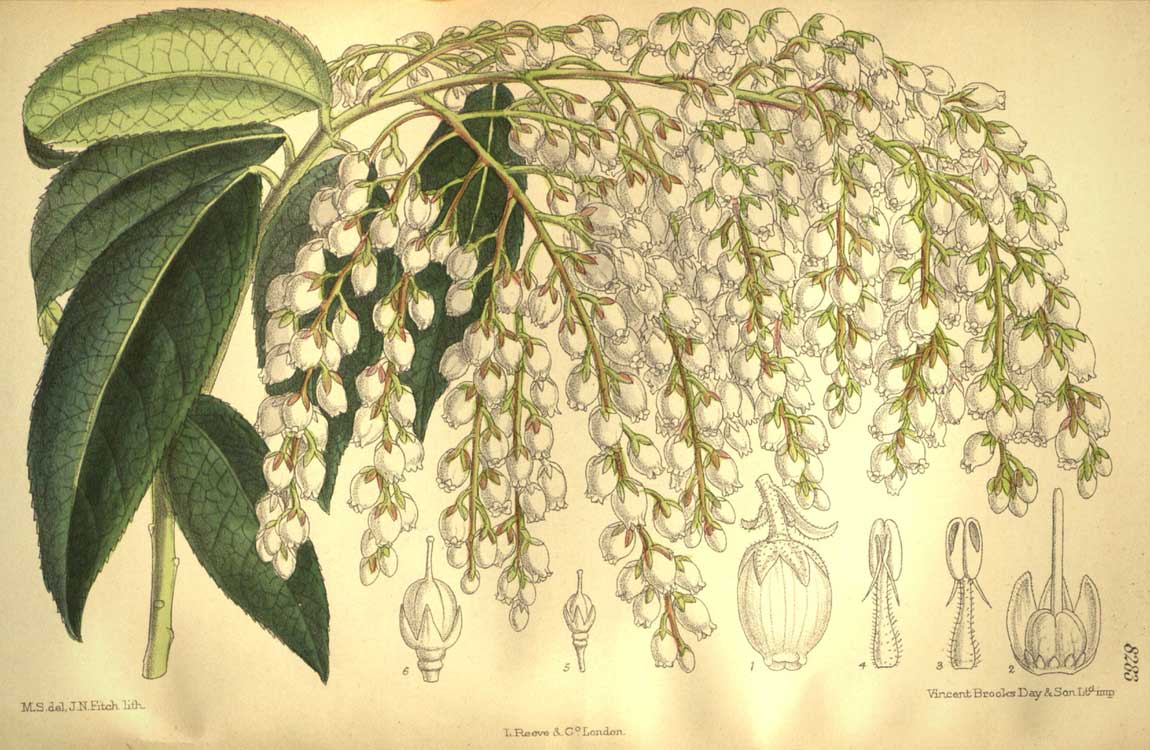
Pieris formosa: botanical illustration
Pieris is a slow-growing bush. It has an upright or rounded shape, sometimes spreading. Most varieties can reach up to 4 metres high. There are dwarf varieties: for instance, ‘Little Heath’ does not exceed 60 cm in height. As for Pieris nana, it measures only 10 cm high! The most compact Pieris are perfect for pot cultivation, while for a hedge, those with larger growth, such as the very common variety ‘Forest Flame’, are preferred.
The Japanese Andromeda offers a spring flowering, between March and May. It bears a multitude of white bell-shaped flowers, gathered in panicles. They have the same shape as those of lily of the valley (urceolate flowers). They measure up to 1.5 centimetres in length. The corolla is composed of five fused petals forming a bell whose tip is marked by five small teeth. This corolla is surrounded by five sepals, and it contains ten stamens and a style. The flowers are small, but their large number sometimes makes the inflorescence impressive, as seen in Pieris japonica ‘Débutante’, a variety that is covered in a multitude of white flowers in spring!
The Japanese Andromeda produces flower buds in autumn, and they remain in place throughout winter, adding new decorative interest to the bush before they reveal the flowers in early spring.
The flowers are generally white, but they can also be pink, more or less pronounced, sometimes almost red. ‘Valley Valentine’ is one of the few varieties to offer red-pink flowers. The flower buds can also be coloured: they are red in Pieris japonica ‘Flamingo’.
The flowers are gathered in panicles that usually measure between 8 and 15 centimetres in length. In some varieties, they can reach 25 centimetres long… making the flowering truly spectacular! The panicles are often trailing, but they can also be upright, as in Pieris floribunda.
The flowers of the Andromeda are melliferous – they are appreciated by bees and other insects that come to forage, transporting pollen from one flower to another.
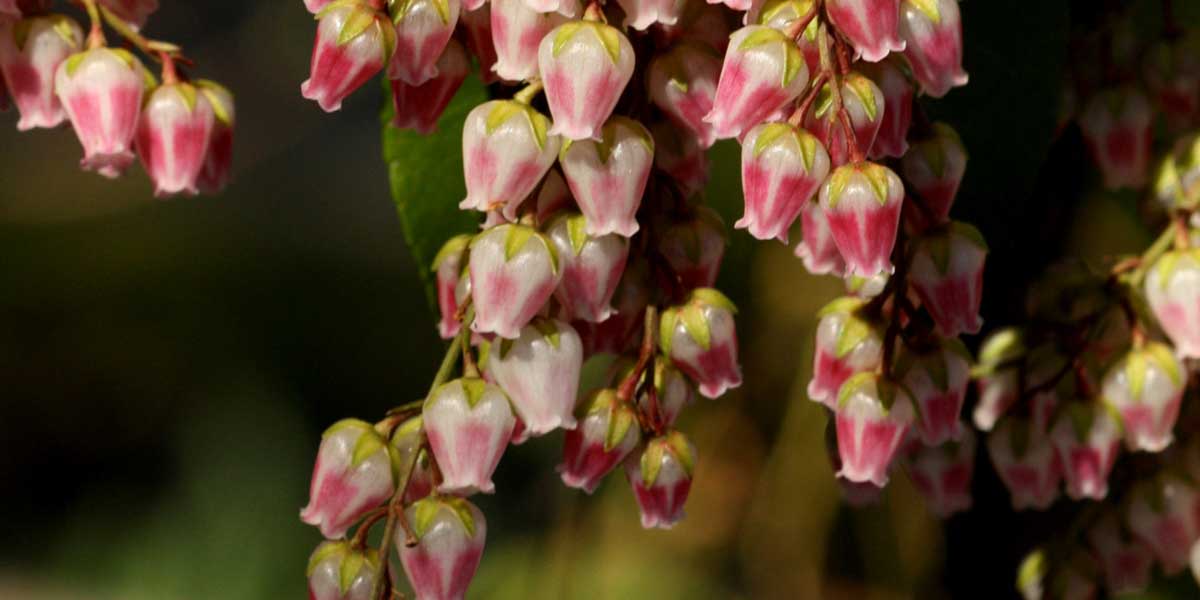
The bell-shaped flowering of Pieris japonica.
The foliage of the Andromeda is evergreen, which makes it decorative even in winter… And, in a hedge, it will remain effective all year round as a screen. The leaves are entire and oblong, with a very ordinary shape. They are slightly crenate at the edges. This is precisely what differentiates Pieris from the genus Andromeda, which has smooth leaves. The leaves of Pieris are glossy, thick, leathery, and petiolate. They are generally alternate, sometimes whorled, but they form denser groups of leaves at the tips of the branches.
The young leaves of Pieris are impressive for their often bright red colour, sometimes coppery or bronze. In some varieties, such as ‘Forest Flame’, they change colour in succession (for example red, pink, then cream white). This characteristic of having bright red young leaves is also found in another bush: Photinia x fraseri ‘Red Robin’, which is also evergreen. The leaves of Pieris then take on a dark green colour, with a well-marked central vein, lighter in colour. They are either solid or variegated with cream white, as in ‘Flaming Silver’.
The leaves of Japanese Andromedas generally measure between 5 and 10 centimetres in length. Those of Pieris ‘Forest Flame’ are among the largest, reaching up to 12 centimetres, while those of Pieris nana are much smaller and measure less than one centimetre long… (but this is an exception!)

The foliage of Pieris japonica / That of Pieris ‘Little Heath’ is marginate with white (photo Megan Hansen) / The young leaves of Pieris ‘Katsura’ take on a lovely burgundy – purple hue
After flowering, in summer or autumn depending on the varieties, Pieris produces brown capsules with five chambers, which open when mature to release the many small seeds they contain.
Read also
Rhododendron: planting, growing and careThe main varieties
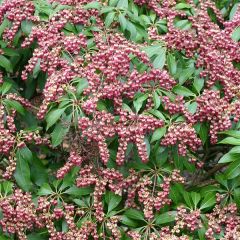
Japanese Andromeda - Pieris Japonica Valley Valentine
- Flowering time April, May
- Height at maturity 1,20 m
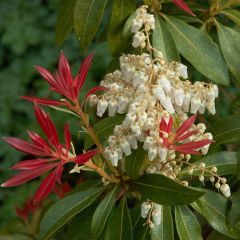
Japanese Andromeda - Pieris japonica Forest Flame
- Flowering time May, June
- Height at maturity 1,50 m
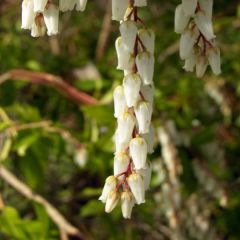
Pieris japonica Mountain Fire - Japanese Andromeda
- Flowering time May, June
- Height at maturity 2 m

Pieris japonica Little Heath - Japanese Andromeda
- Flowering time March to May
- Height at maturity 60 cm
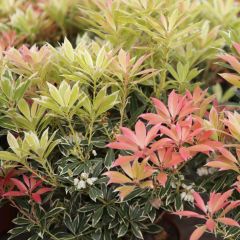
Pieris japonica Flaming Silver - Japanese Andromeda
- Flowering time May, June
- Height at maturity 1,25 m
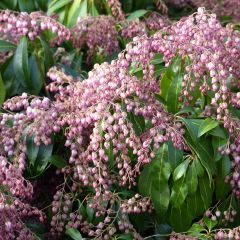
Pieris japonica Katsura - Japanese Andromeda
- Flowering time March to May
- Height at maturity 1 m
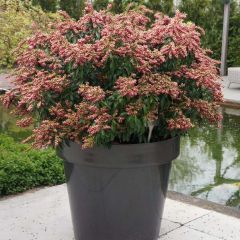
Pieris japonica Passion - Japanese Andromeda
- Flowering time April, May
- Height at maturity 1 m
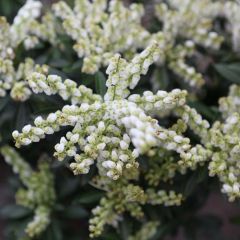
Pieris japonica Debutante - Japanese Andromeda
- Flowering time April, May
- Height at maturity 80 cm
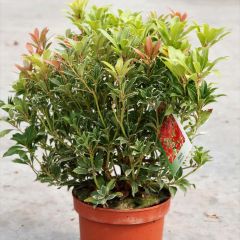
Pieris japonica Carnaval - Japanese Andromeda
- Flowering time May, June
- Height at maturity 1,50 m
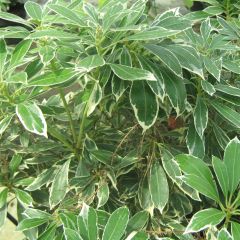
Pieris japonica Ralto Rose - Japanese Andromeda
- Flowering time April, May
- Height at maturity 80 cm
Discover other Pieris
View all →Available in 0 sizes
Available in 3 sizes
Available in 1 sizes
Available in 2 sizes
Available in 1 sizes
Available in 1 sizes
Available in 2 sizes
Available in 1 sizes
Available in 1 sizes
Available in 1 sizes
Young plantation
Where to plant?
Pieris japonica thrives in partial shade. In dense shade, its flowering will be less generous. It can tolerate a sunny position, but avoid scorching sunlight. If you live in the Mediterranean region, prefer a shaded location, while in northern France, it can be planted in full sun.
Plant your Pieris in a rather acidic substrate, as it is a heather soil plant. If your soil is calcareous, it is better to plant it in a pot. Otherwise, it may develop chlorosis, which is characterised by yellowing of the foliage between the veins (as the assimilation of mineral elements is blocked by the lime present in the soil). In any case, it is advisable to add some heather soil at planting time.
Plant it in a location protected from cold winds. Late frosts are likely to damage the young spring shoots.
Andromeda appreciates humus-bearing soils, which is why we recommend adding well-decomposed compost at planting, and then each year thereafter.
The substrate must be draining to prevent the appearance of phytophthora. If your soil is heavy, compact, or clayey, it will retain water and may thus encourage fungal diseases. Be sure to add draining materials at planting: pumice, gravel…
You can certainly grow Pieris in a container and place it on a balcony or terrace. This is a good solution if you live in the city or if your soil is calcareous. Choose the most compact varieties for this.
When to plant?
Plant Japanese Andromeda in autumn or spring, outside of frost periods.
How to plant?
- Start by digging a planting hole, about twice the size of the root ball.
- Add a mixture of potting soil, well-decomposed compost, and heather soil.
- Place the bush, then backfill the hole and gently firm it down.
- Water thoroughly.
- Apply a layer of mulch at the base of the bush.
Continue to water regularly during the first year, but without excess to avoid the development of fungal diseases (notably Phytophthora).
You can also plant Pieris in a pot. Choose a container that is large enough and deep, then plant in a mixture of potting soil and heather soil. In a pot, Pieris will require more regular watering than in the ground.
Read also
Plant young ericaceous plantsCare
Pieris requires watering, especially during the year of planting; in subsequent years, you can simply water during the summer and in periods of drought. Use non-calcareous water, ideally rainwater. Container-grown Pieris need more regular watering.
We recommend applying a mulch in autumn, made of fallen leaves, fern fronds, or pine bark. This will help keep the soil cool for longer and reduce the need for watering. Additionally, it will limit the growth of weeds, making maintenance of your bed easier. Pieris will also appreciate a spring application of fertiliser or well-decomposed compost. If you live in a cold region, do not hesitate to install a winter cover. Young shoots are sensitive to late frosts.
Pruning Pieris is optional; it can certainly do without it… but it will allow you, especially with the larger varieties, to give them a compact shape and limit their height. Pruning should be done once flowering is finished. Cut back damaged or poorly positioned branches. In any case, even if you do not prune Pieris, we recommend removing faded flowers for aesthetic reasons and to prevent exhausting the plant unnecessarily.
Pieris japonica is sometimes attacked by Phytophthora, which is favoured by a combination of heat and humidity. The leaves dry out, and the plant quickly declines. Unfortunately, there is no curative treatment, only preventive measures, which involve planting in well-draining soil and limiting watering. It is also susceptible to leaf spots, caused by fungal diseases (notably the fungus Phyllosticta maxima). If you see spots appearing on the foliage of your Pieris, we recommend removing and burning the affected leaves. Reduce watering and apply a fungicide.
Pieris japonica is rarely attacked by pests. However, it can be affected by the Pieris tiger: this is an insect that pierces and sucks the sap of the plant, leading to leaf drop and general decline of the bush. It can also be found on rhododendrons and skimmia.
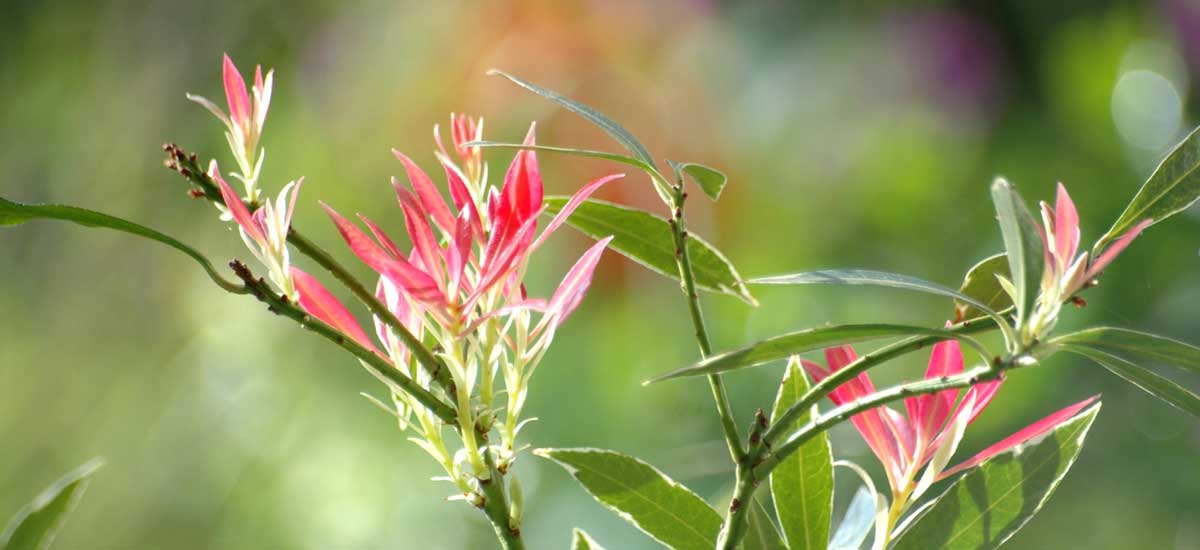
Multiplication
Sowing
You can sow Pieris seeds in spring or autumn; however, this delicate technique is best reserved for experienced gardeners.
- Prepare a pot with potting soil, water it, and gently firm it down.
- Place the seeds on the surface, then press each one down slightly so that they are half buried. Cover with a very thin layer of medium: Pieris seeds need light to germinate.
- Position the pots in a bright location but out of direct sunlight.
- Regularly moisten the medium (ideally using a spray bottle), but avoid overwatering.
The seeds should take about a month to germinate.
Propagation by Cuttings
Pieris can be propagated by cuttings in mid to late summer (August-September), once flowering has finished, using semi-woody shoots.
- Fill a pot with potting soil mixed with sand or perlite, then water it. Firm it down lightly.
- Take a shoot about ten centimetres long, from the tip of a healthy, flexible branch. Cut cleanly just below a leaf node.
- Remove the leaves from the bottom of the cutting, leaving only a few towards the tip of the stem.
- You may dip the base of the cutting in plant hormone.
- Plant the stem in the medium, and firm it all around.
- Place the pot out of direct sunlight, at a temperature of around 20 °C.
Water regularly to keep the medium moist. The cutting should root in about two months.
Layering
You can also perform layering by laying down a branch in late summer, around September.
- Choose a long, flexible branch, close to the ground.
- Incise the bark on the underside of the branch. Remove the leaves located in the middle of the branch, leaving only a few at the tip.
- Dig a shallow trench.
- Lay the branch in the trench and hold it in place with a hook. Cover with soil, leaving the tip of the branch above the ground (secure it with a stake to keep it upright).
- Water.
New roots will develop. You can then separate the young plant from the original plant.
Association
The best combination is to pair Pieris with other ericaceous plants, particularly rhododendrons, which it complements beautifully! Plant some heathers alongside them, as well as shrubs like camellias, kalmia, or skimmia. You can also associate it with other closely related plants, such as campanulate Andromeda, Enkianthus campanulatus, a deciduous bush valued for its stunning autumn foliage, or the Podium-leaved Andromeda, Andromeda polifolia, which has very fine leaves and pink bell-shaped flowers.
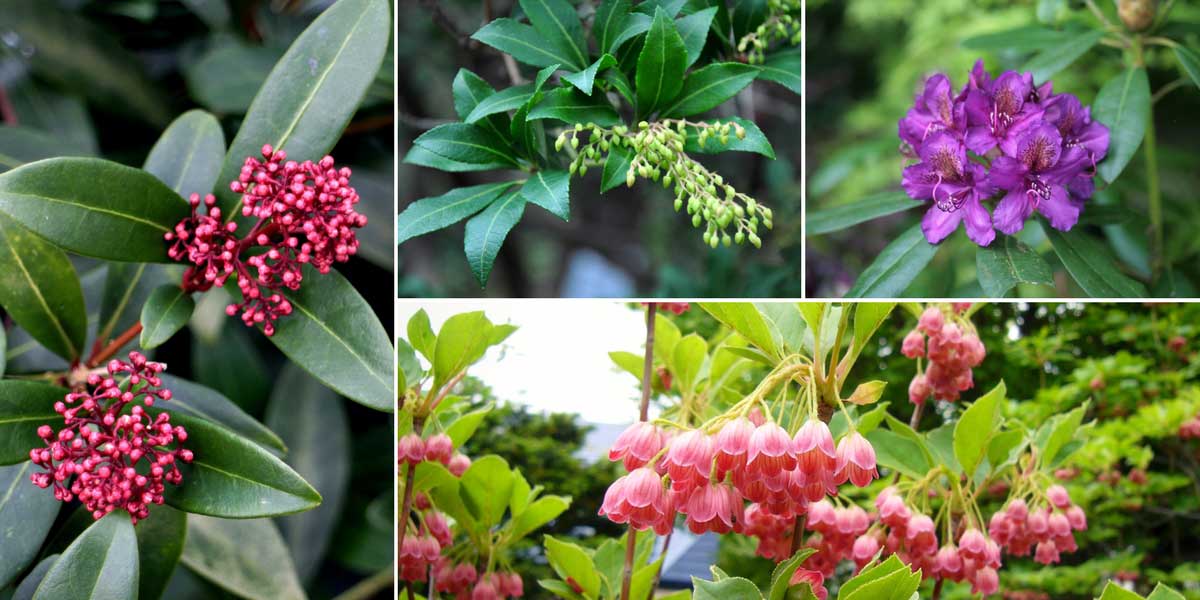
Skimmia japonica ‘Rubella’ (photo Dominicus Johannes Bergsma), Pieris japonica, Rhododendron ‘Marcel Menard’ and Enkianthus campanulatus (photo Searobin)
With its dense evergreen foliage, Pieris is ideal for hedging: it immediately creates an effective and decorative screen in spring. Compose a free-form hedge by pairing it with viburnums, hornbeams, Prunus laurocerasus, spireas, elderberries, privet, abelia… In addition to having a natural and lively appearance, this type of hedge will require little maintenance!
Combine the stunning colours of Pieris with other decorative foliage, among the lighter ones: ferns, ornamental grasses, sweet woodruff, sacred bamboo, or mahonia ‘Soft Caress’. This allows for a contrast with the thick, glossy leaves of Pieris, adding more delicacy. As Pieris enjoys semi-shaded conditions, it easily accompanies shade plants and decorative foliage such as ferns, brunnera, heucheras, pachysandra, or hostas.
Play with colours by planting alongside other plants with fiery foliage: Japanese maples, Phormium, heucheras, coleus, persicarias, or even grasses: Imperata cylindrica ‘Red Baron’ or Uncinia rubra… Add some spring blooms in warm tones: red or orange tulips, Euphorbia griffithii, primroses, Geum coccineum… You will achieve a stunning bed with warm and vibrant hues!
By choosing larger varieties, such as ‘Forest Flame’, Pieris can form a remarkable backdrop in a flower bed. Accompany its colourful foliage and bell-shaped flowers with other spring flowers, such as spring bulbs. You can plant it in groups of three or five at the back of a bed, and place perennials and bulbs in front of it: daffodils, crocuses, hyacinths… Also consider primroses and Oriental hellebores.
Useful resources
- Our range of Japanese Andromedas!
- Find our advice sheet on how to grow a Pieris in a pot
- To accompany them, discover other heather soil bushes! They pair perfectly and have very similar growing conditions.
- Check out our advice sheet – Planting heather soil bushes
- An article by Michael on our blog – 5 tips to successfully grow heather soil bushes
- Advice sheet: Diseases and pests of Pieris
- How to prune the Japanese Andromeda or Pieris? Find our tips in this tutorial.
- Japanese Andromeda: 6 varieties to plant in a pot
Frequently asked questions
-
The foliage of my Pieris is discolouring and drying out! What should I do?
This problem is caused by a fungus, Phytophthora cinnamomi. It rots the roots and prevents the circulation of sap, leading to the decline of the plant. The leaves turn yellow and dry out. A humid environment promotes its development, which is why we advise you to work on drainage as a preventive measure. Unfortunately, there is no curative treatment. If the disease is well advanced, do not hesitate to uproot the bush and burn it, to prevent it from contaminating your other plants... especially if you have other Ericaceae nearby. Subsequently, do not plant other plants from this family in that location, as the fungus is present in the soil.
-
The foliage of my Pieris is turning yellow!
If the leaves turn yellow between the veins, making them very visible, this is chlorosis: the lime present in the soil blocks the assimilation of mineral elements, leading to the discolouration of the foliage! To avoid this, it is preferable to grow Pieris in slightly acidic soil. To remedy this, consider adding heather soil, or ideally, growing it in a container with a mix of potting soil and heather soil!
-
The foliage of my Pieris is spotted!
Pieris are susceptible to leaf spots caused by fungal diseases. Remove and burn affected leaves to limit the development of the disease. Then apply a fungicidal treatment (Bordeaux mixture, sulphur, horsetail decoction...). Reduce watering, allowing the substrate to dry out between waterings, as moisture promotes these fungal diseases.
- Subscribe!
- Contents































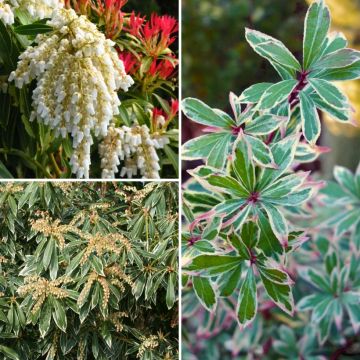



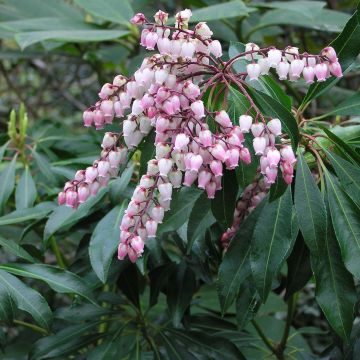

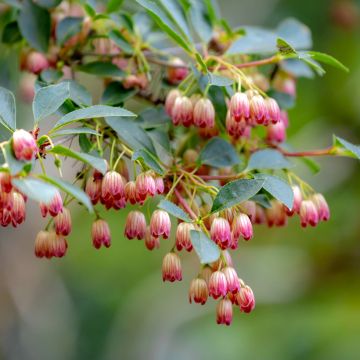
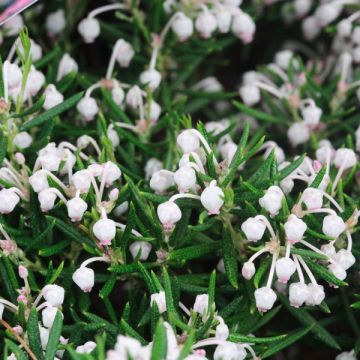
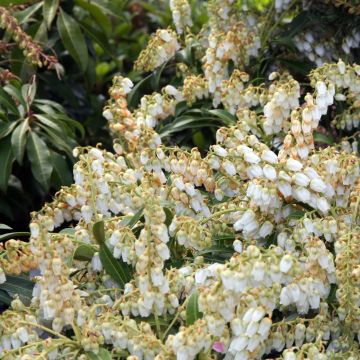

Comments